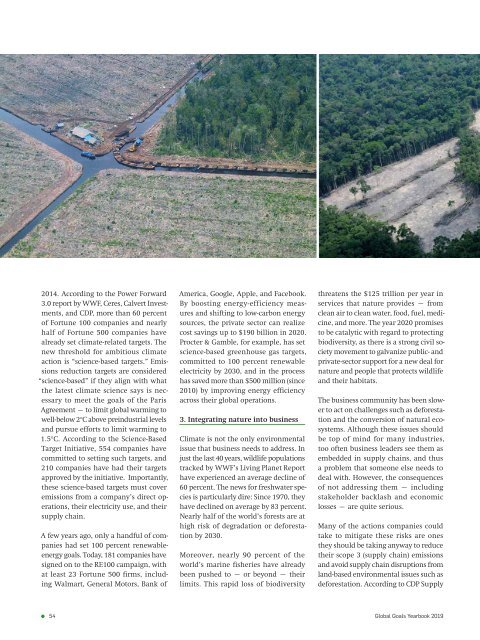Aliging Profit with Purpose - Global Goals Yearbook 2019
What are companies for? The rules for companies have changed. The focus is increasingly on their sustainable, social, and ecological impacts. The strategic orientation toward the so-called corporate purpose is decisive for profitable growth in the future. This currently results in a large number of questions for businesses: How do you find an inspiring and future-oriented corporate purpose, and how can it be aligned in such a way that it brings profitable growth and social responsibility in concert? The new 2019 edition of the Global Goals Yearbook offers answers to these crucial questions thanks to its consistent orientation toward the UN Sustainable Development Goals and a competent editorial board and author pool.
What are companies for? The rules for companies have changed. The focus is increasingly on their sustainable, social, and ecological impacts. The strategic orientation toward the so-called corporate purpose is decisive for profitable growth in the future.
This currently results in a large number of questions for businesses: How do you find an inspiring and future-oriented corporate purpose, and how can it be aligned in such a way that it brings profitable growth and social responsibility in concert? The new 2019 edition of the Global Goals Yearbook offers answers to these crucial questions thanks to its consistent orientation toward the UN Sustainable Development Goals and a competent editorial board and author pool.
You also want an ePaper? Increase the reach of your titles
YUMPU automatically turns print PDFs into web optimized ePapers that Google loves.
2014. According to the Power Forward<br />
3.0 report by WWF, Ceres, Calvert Investments,<br />
and CDP, more than 60 percent<br />
of Fortune 100 companies and nearly<br />
half of Fortune 500 companies have<br />
already set climate-related targets. The<br />
new threshold for ambitious climate<br />
action is “science-based targets.” Emissions<br />
reduction targets are considered<br />
“science-based” if they align <strong>with</strong> what<br />
the latest climate science says is necessary<br />
to meet the goals of the Paris<br />
Agreement – to limit global warming to<br />
well-below 2°C above preindustrial levels<br />
and pursue efforts to limit warming to<br />
1.5°C. According to the Science-Based<br />
Target Initiative, 554 companies have<br />
committed to setting such targets, and<br />
210 companies have had their targets<br />
approved by the initiative. Importantly,<br />
these science-based targets must cover<br />
emissions from a company’s direct operations,<br />
their electricity use, and their<br />
supply chain.<br />
A few years ago, only a handful of companies<br />
had set 100 percent renewableenergy<br />
goals. Today, 181 companies have<br />
signed on to the RE100 campaign, <strong>with</strong><br />
at least 23 Fortune 500 firms, including<br />
Walmart, General Motors, Bank of<br />
America, Google, Apple, and Facebook.<br />
By boosting energy-efficiency measures<br />
and shifting to low-carbon energy<br />
sources, the private sector can realize<br />
cost savings up to $190 billion in 2020.<br />
Procter & Gamble, for example, has set<br />
science-based greenhouse gas targets,<br />
committed to 100 percent renewable<br />
electricity by 2030, and in the process<br />
has saved more than $500 million (since<br />
2010) by improving energy efficiency<br />
across their global operations.<br />
3. Integrating nature into business<br />
Climate is not the only environmental<br />
issue that business needs to address. In<br />
just the last 40 years, wildlife populations<br />
tracked by WWF’s Living Planet Report<br />
have experienced an average decline of<br />
60 percent. The news for freshwater species<br />
is particularly dire: Since 1970, they<br />
have declined on average by 83 percent.<br />
Nearly half of the world’s forests are at<br />
high risk of degradation or deforestation<br />
by 2030.<br />
Moreover, nearly 90 percent of the<br />
world’s marine fisheries have already<br />
been pushed to – or beyond – their<br />
limits. This rapid loss of biodiversity<br />
threatens the $125 trillion per year in<br />
services that nature provides – from<br />
clean air to clean water, food, fuel, medicine,<br />
and more. The year 2020 promises<br />
to be catalytic <strong>with</strong> regard to protecting<br />
biodiversity, as there is a strong civil society<br />
movement to galvanize public- and<br />
private-sector support for a new deal for<br />
nature and people that protects wildlife<br />
and their habitats.<br />
The business community has been slower<br />
to act on challenges such as deforestation<br />
and the conversion of natural ecosystems.<br />
Although these issues should<br />
be top of mind for many industries,<br />
too often business leaders see them as<br />
embedded in supply chains, and thus<br />
a problem that someone else needs to<br />
deal <strong>with</strong>. However, the consequences<br />
of not addressing them – including<br />
stakeholder backlash and economic<br />
losses – are quite serious.<br />
Many of the actions companies could<br />
take to mitigate these risks are ones<br />
they should be taking anyway to reduce<br />
their scope 3 (supply chain) emissions<br />
and avoid supply chain disruptions from<br />
land-based environmental issues such as<br />
deforestation. According to CDP Supply<br />
54 <strong>Global</strong> <strong>Goals</strong> <strong>Yearbook</strong> <strong>2019</strong>

















